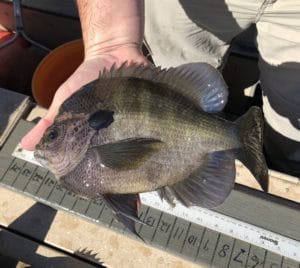
25+ Inch Trophy Bass
All lakes are not created equal and several factors come into play when it comes to bass management. These include, but are not limited to, the size of the lake, the primary productivity of the lake, the length of the growing season, and bass genetics. However, we consider one of the most important factors to be the number and size of forage available in the lake. The key to growing trophy bass is to keep their densities low and surround them with an endless supply of forage; preferably the largest thing they can fit in their mouth. The best way to do this is to routinely harvest less desirable bass and increase the size of your bluegill with a supplemental feeding program. Under this plan, alternate forage species may need to be periodically stocked into the system. These can include tilapia, shad, or crawfish.

Optimal Forage for Growing Trophy Bass
The trophy bass basics
One of the biggest trade-offs when managing for trophy bass is that angling catch rates often go down. Florida bass genetics have some influence here; however, the biggest factor is that the bass have easy access to optimal sized, natural food. In a trophy system, they expend very little energy in catching their next meal. This maximizes their weight gain. In these types of lakes, bass are less prone to be fooled into pursuing a fast moving, artificial lure. One way to counter this is to use larger artificial baits presented with a slower retrieve. However, inexperienced anglers often consider this type of fishery as unsatisfactory.
Quality bass management is different
A quality fishery is managed a little differently. The goal is to produce a fishery in which anglers can easily catch numerous fat, healthy bass measuring 15-20 inches. A quality management plan does not necessarily mean you have to give up all hope of catching a wall-hanger. In fact, we have produced fish larger than 13 pounds under this type of management. Under a quality bass management program, it is still important to harvest undersized bass. However, we establish the “maximum harvest length” at a smaller size.
Quality bass fishing is more enjoyable to all skill levels of anglers. It is also more practical from a financial standpoint as it reduces costs involved with superior genetics, increased harvest using electrofishing equipment, and supplemental forage stocking.
The ultimate goal of the lake owner is the primary deciding factor when choosing between implementing a quality or trophy management plan. It should be noted that transitioning from an existing quality program to a future trophy program can be accomplished by increasing “maximum harvest lengths” and adhering to strict bass harvest quotas. However, transitioning the other way may take several years without costly corrective stocking.
